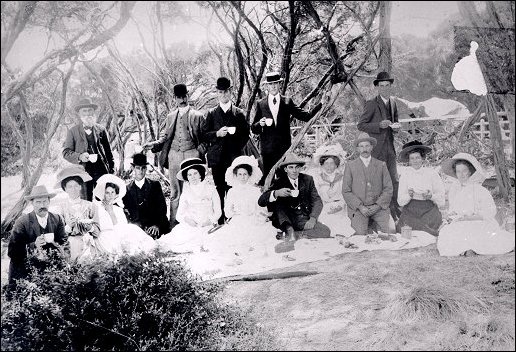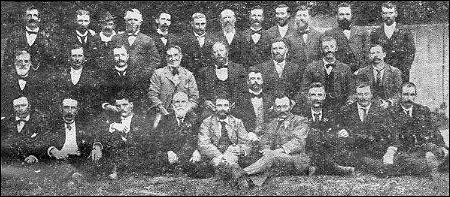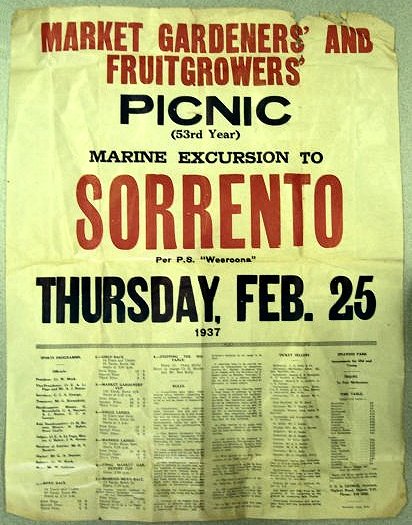Market Gardeners’ Picnic

Market Gardeners’ Picnic, c1900. Courtesy Moorabbin & District Historical Society.
Over many years, after the settlement of Melbourne in the 1830s and the creation of the Colony of Victoria in 1850, migrants were able to establish market gardens in the sandy soil to the south. Often illiterate and lacking in trades or extensive agricultural experience, these individuals were prepared to battle the climatic conditions, and use manure in order to improve the fertility of the soil to produce saleable crops. They were hard working and God fearing people who paused in their daily activities on Sundays so that they could attend their church to join in the worship of their God with other members of the community. There was at least one other day when work in the market gardens ceased. This was the day of the Market Gardeners’ Picnic.
The first picnic was held in association with the Market Gardeners and Fruit Growers’ Association on April 3, 1884 at Lilydale. Groups of market gardeners travelled by train with their families from Cheltenham, and stations further north, to Lilydale at a cost of three shillings and six pence for adults and two shillings for children under 15 years. On arrival a band played music to accompany dancing ‘on the green’, and foot races were held as well as other sporting events. This pattern of activities was followed for more than fifty years although the location of the picnic changed and the mode of transportation varied.
For the first two years the destination of the trains was Lilydale but the following year the venue was changed to Beaconsfield where over 2000 people attended. In 1890, for the seventh annual picnic, Mornington was the destination for the pleasure seekers. They travelled by steam train starting from East Brighton (Bentleigh) accompanied by the lively music of the Kew Premier Brass Band. When the train reached South Brighton and Cheltenham there was little room to accommodate waiting passengers so they had to wait for the second and third trains. A newspaper report drew attention to some of the features of the journey, including the Carrum Swamp where some reclamation works were in progress. The reporter went on, “It is intended to drain this piece of country, which extends over 9,000 acres by cutting a large drain 90ft. wide and several miles in length which will then, it is hoped, carry away the foot or more of water which has lain there for years.” [1] The report continued, “the extensive holding belonging to a Mr Chapman which here and there indicates that the land fever had also reached there. During the land boom a good slice of this estate changed hands at from £50 to £100 per acre, and was, of course, afterwards cut up into building allotments and sold at a fairly good profit. Here and there, however, are standing out prominently ‘This allotment for sale’ in large letters on the indispensable boards, which forces the conclusion upon one that the vendors are anxious to part with their ‘bargain’.”
Subsequent years saw the change of destination from Yan Yean to Bacchus Marsh to Mornington. In 1893 the committee examined several sites but recommended Bacchus Marsh because it had a large fenced in park with every convenience together with a good running track. However, the committee recognized that they were living in depressed times and people could not afford to pay a high price for train tickets. Wanting no one to be deprived of the benefits of attending, they decided to subsidise the price of tickets from accumulated funds so that fares could be set at four shillings and six pence for an adult travelling from Mordialloc and two shillings and six pence for a child. People joining the train at later stations, Cheltenham, Highett, South Brighton, East Brighton, McKinnon and North Road, paid less.

Market Gardeners’ and Fruit Growers' Picnic Committee - Annual outing, to Healesville, 1901.
It was in 1896 that a marine excursion was considered for the first time. Various places were proposed for the picnic in that year but it was finally the wish of the majority of the organising committee that the PS Ozone be hired, at £60 for the day, to convey the picnic-makers to Queenscliff. The cost to participants was 2/6 per adult and 1/6 per child but this did not include the cost of the special train fare from Mordialloc. Meals were available on board the steamer at 1/6 and the caterer promised a £2 donation to the sports fund. Once again the Brighton Brass Band was engaged to provide the musical entertainment. [2]
A few days before the commencement of the excursion to Queenscliff the organising secretary was informed the Ozone was not available. After hurried negotiations the Hygeia was obtained as a replacement but on the condition that the departure time was delayed to half past ten. This delay upset the arrangements at Queenscliff and provided a wearisome wait for the passengers but it allowed the picnic to go ahead. The voyage to Queenscliff, according to a newspaper report, was “pleasant with a gloriously fine day.” The Brighton Brass Band supplied two groups, one a brass band of twelve players and the other a string band of three. Of the latter, the report said, “the least said the better but the brass band played an excellent series of popular airs. … During the journey a space was cleared on the deck and dancing couples moved merrily to the music, or, in some instances to the rhymatic roll of the steamer.” [3] After embarking the 960 passengers for the return journey the Hygeia left Queenscliff at 5 o’clock and arrived at Port Melbourne before 7.30. Apparently it was an almost unanimous verdict that the picnic was the most enjoyable held by the Market Gardeners’ and Fruit Growers Association Picnic Committee.

Members of the Market Gardeners’ Picnic Committee, c1930 Back Row: (left to right) N Woff, Unknown, W Sullivan, V Barnett, Unknown, C Baker, Unknown, C James. Middle Row: G Stayner, H Besant, E Le Page, B Kelly, Unknown, Unknown, A Bunny, Unknown. Front Row: T Marriott, C C A George, H Baker, W Mock, T Marriott, G Brownfield, Caleb Porter, W H Stooke. Courtesy Ira Reynolds.
The following year the committee aimed to repeat this success. The Hygeia was once again hired to take the picnickers to Queenscliff, but this time the weather was not so favourable. The Brighton Southern Cross reported the reactions of the passengers, “They are as used to rain as ducks to water, and in most cases like it as much. But to be tossed about on the sea was an unusual experience to most of them, and as might be expected many showed unmistakable symptoms of being very much upset.” [4] In 1901 the innovation of having a rail and marine excursion was introduced, allowing people to travel to the selected venue by rail or boat.
In 1907 five hundred people decided to travel by train while 1480 were passengers onboard the Hygeia, 70 fewer than the previous year. This decrease was attributed to the insane and scurrilous utterings of an eccentric woman published in the metropolitan papers. She predicted that the Hygeia was going to sink with all on board perishing. So impressed were some people, the Moorabbin News reported, that they sold their boat tickets at 1/6. The report conceded she was correct in one respect as the boat did go down but not to the bottom of the bay but to Mornington. [5] By 1915 the Weeroona had taken the place of the Hygeia and Ozone as the means of transporting the picnickers to their destination and continued in that role into the 1930s.
An important feature of all picnic days, right from its inception in 1884, was the Market Gardeners’ Cup, a handicapped race over 120 yards. By 1914 the prize for the winner was £7 and twenty years later had increased to £10 10s. This race involved the running of several heats, and was regarded by many as the highlight of the day’s entertainment but there were other events which drew participants. There were the bicycle races, the girls’ race, the race for market gardener employees, a boys’ race, a married women’s race as well as one for single ladies, and a race for old duffers. In 1907 a special race for committee members was introduced and after the First World War returned soldiers were able to compete for a prize of £2 2s.
Racing was not the only form of entertainment. Music was provided on the voyage down to the picnic venue by bands who successfully tendered for the opportunity to display their skill. The Brighton Brass Band featured on many occasions but the East Brighton ,Malvern and Kew bands were used in different years. The Moorabbin News reporter believed the music of the Kew Band on the 1919 picnic, unlike other occasions, was flat and stale. [6] For 1934 the Moorabbin Shire Band was engaged to play on the trip to Queenscliff and to provide the music for the dancing in the Palais at the sports ground.
In 1906 a business man offered to provide a Punch and Judy and performing dog show for a small consideration but the organising committee was quick to dismiss the offer. However permission was given to Mr Westwood to erect a merry go round on the ground, provided that it did not interfere with the racing. [7] Judging from the noise emanating from a tent, the Southern Cross reporter believed the sword swallowing and juggling men were doing a good business. [8] The same reporter wrote of the steady stream of people visiting the fortifications at Queenscliff where they were admitted in groups of fifty. A soldier, he said, told his senior officer that he trotted the visitors around in nine and a half minutes, half a minute under regulation time and “told ‘em all I knew and a lot I didn’t know; had to draw on my imagination a bit. Nice lot of girls, sir, ‘ope they come again.”
The availability of other entertainment options would have pleased Cr Brownfield, a committee member, for he believed there was too great an emphasis on foot racing. [9] Two years later, in 1908, a reporter from the Southern Cross was arguing that genuine interest in the racing was confined to the runners and immediate friends. He suggested the members of the organising committee were industriously employed in catering for others amusement, without having a moment to themselves, by conducting a dozen 100 yard or 120 yard sprints. They could save themselves a lot of trouble and cut down expenses without affecting the popularity of future picnics by including a few ‘muff’ events..
Generally the Market Gardener picnics were conducted trouble free because of the careful planning of the committee and the presence of some of the local constables amongst the pleasure seekers.. But there was the occasional protest that had to be addressed as well as other matters of concern. For example, a young boy whispered into the ear of the treasurer, in 1914, that the winner of the boys’ race was in fact over fourteen years old and therefore not eligible to compete. [10] Perhaps a more serious allegation was when it was claimed that the winner of the employees’ race was not an employee of any market gardener. The committee investigated the grumble and determined the accusation was not correct.
As market gardeners were viewed by some as not belonging to the ‘hilarious class’, and the majority of them were strict teetotallers, [11] it is not surprising that many were worried about the number of young men who were becoming intoxicated on the steamer travelling to and from the picnic site. Cr Burgess, the committee president, believed most of the crowd were orderly and respectable. He claimed there were only one or two who were noisy and affected by drink but Cr Barnett disagreed with him believing the recent picnic was the worst they had had in regard to drinking. Other committee members recognized that there was excessive drinking amongst some of the young men and they did cause an annoyance to respectable people but the problem was not extensive nor an agreed solution evident. [12]
Over thirty people were present to witness the running of the Market Gardeners’ Cup in 1901 won by W Thorne. This was one occasion when the full organising committee had to adjudicate on a race protest. The claim was that Thorne was ineligible to race in the prestige event because he was not a bona fide market gardener. The committee ruled otherwise but only on the majority of twelve votes to eight, so the matter was not clear cut. [13]
A bill from the Mornington chemist for four shillings and six pence caused a lengthy discussion amongst committee members in 1908. A competitor in the bicycle race fell and injured himself necessitating medical attention. Although some committee members thought he was responsible for the accident others were not convinced. However, secretary Clements was enraged by the size of the chemist’s account saying that he would see the chemist hanged before he would pay four shillings and six pence for “two pennyworth of arnica and three pennyworth of lint.” [14] The chemist responded to the secretary’s words with a letter from his solicitor demanding an apology, the payment of his bill, plus ten shillings and six pence for professional costs involved in gaining legal advice. The committee chose not to become involved, leaving the matter in the secretary’s hands to resolve. How the secretary resolved the matter is not known.
By 1915 many of the young men were away fighting the Germans in Europe and the local area was experiencing a drought. Given this situation some members of the organising committee questioned whether the picnic for that year should be held. Finally, it was resolved to go ahead as Mr Burgess, the chairman, said, “the outing should be held as usual, realising that notwithstanding the war and drought, work and play must go on as usual.” [15]
Towards the end of the First World War an epidemic of influenza broke out affecting millions of people around the world. By the beginning of 1919 the disease, known as Spanish Influenza, had arrived in Melbourne and as a consequence the picnic for that year was cancelled. [16] Meetings of more than twenty people were banned, theatres and mechanics’ institutes were closed, and people were encouraged to wear masks. However, by March the situation had improved and the organizing committee arranged to reactivate the previously planned picnic to Sorrento. Nevertheless the picnic was not the success of previous years as only 950 passengers travelled on the boat, a number significantly less than former years and with the exception of the Gardeners’ Cup and the Old Buffers Race interest in the sporting events was poor. A correspondent in the Brighton Southern Cross described the atmosphere as ‘flat’.[17] This situation was explained, in part, by the cold, blowy and rainy weather that interrupted proceedings, and the impact of the First World War on the community but the general malaise surrounding the times was no doubt a factor.

Poster advertising the Market Gardeners' and Fruit Growers' Picnic to Sorrento on February 25, 1937. Courtesy Len Le Page.
Despite the minor disturbances to the smooth organization of the Market Gardeners’ Picnic the event continued for over fifty years until its demise in the late 1930s caused by the commencement of the Second World War. It was the occasion for enjoying the company and camaraderie of friends, obtaining relief from hard work in the paddocks and perhaps winning a few shillings from competing in the sporting events. Many mourned the demise of the Market Gardeners’ Picnic.
Footnotes
- Brighton Southern Cross, March 1, 1890.
- Brighton Southern Cross, February 1, 1898.
- Brighton Southern Cross, February 29, 1898.
- Brighton Southern Cross, February 27, 1897.
- Moorabbin News, March 2, 1907.
- Moorabbin News, March 22, 1919.
- Moorabbin News, 1906.
- Brighton Southern Cross, February 24, 1906.
- Brighton Southern Cross, February 24, 1906.
- Moorabbin News, February 21, 1914.
- Moorabbin News, March 20, 1906.
- Moorabbin News March 2, 1908.
- Brighton Southern Cross, March 16, 1901.
- Moorabbin News March 2, 1908.
- Moorabbin News, March 14, 1914.
- Moorabbin News, March 22, 1919.
- Moorabbin News, Ibid.
